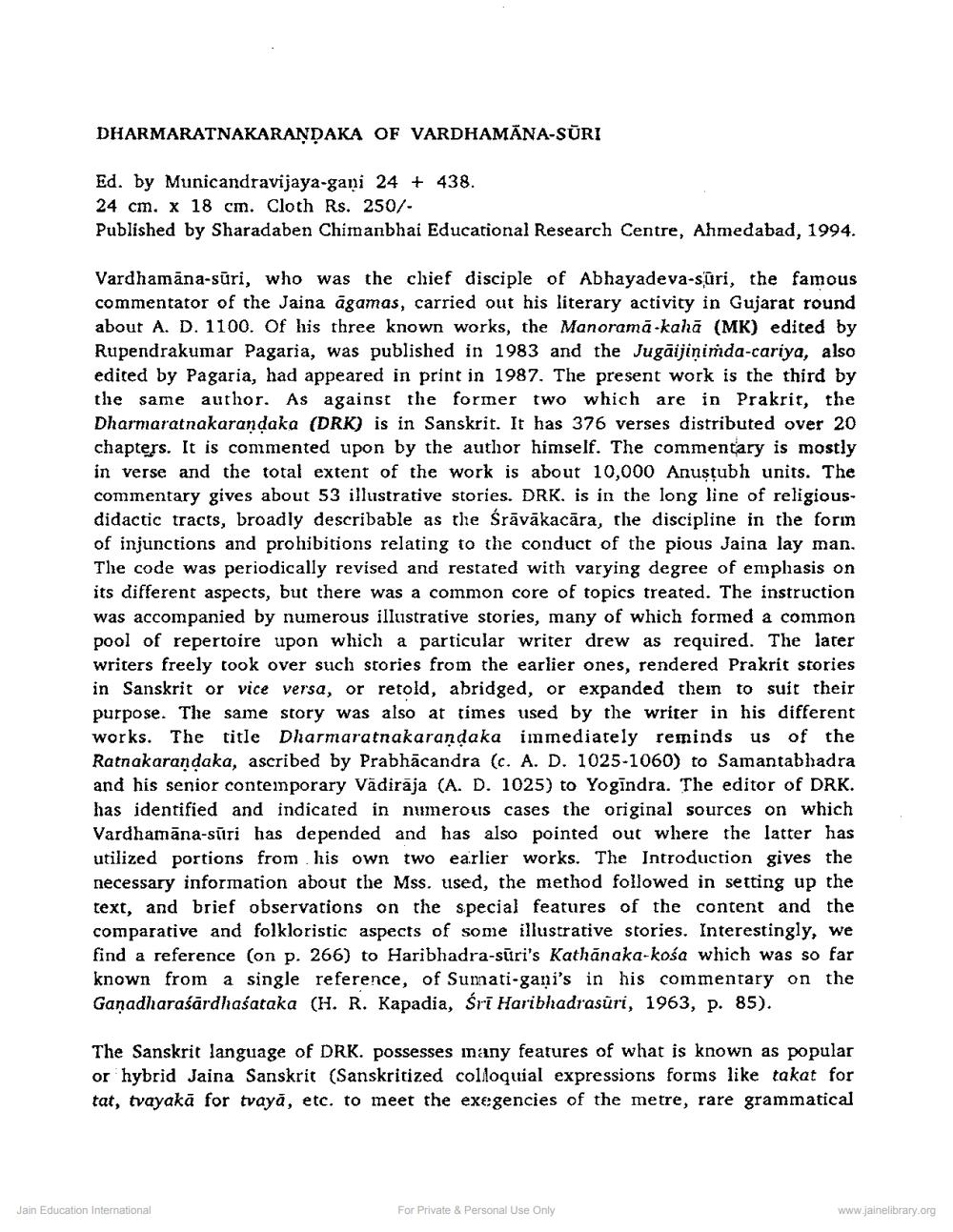Book Title: Dharmratna karandaka of Vardhamansuri Author(s): H C Bhayani Publisher: Z_Nirgrantha_1_022701.pdf and Nirgrantha_2_022702.pdf and Nirgrantha_3_022703.pdf View full book textPage 1
________________ DHARMARATNAKARANDAKA OF VARDHAMANA-SÜRI Ed. by Municandravijaya-gani 24 + 438. 24 cm. x 18 cm. Cloth Rs. 250/ Published by Sharadaben Chimanbhai Educational Research Centre, Ahmedabad, 1994. Vardhamana-süri, who was the chief disciple of Abhayadeva-süri, the famous. commentator of the Jaina agamas, carried out his literary activity in Gujarat round about A. D. 1100. Of his three known works, the Manoramā-kahā (MK) edited by Rupendrakumar Pagaria, was published in 1983 and the Jugaijinimda-cariya, also edited by Pagaria, had appeared in print in 1987. The present work is the third by the same author. As against the former two which are in Prakrit, the Dharmaratnakaraṇḍaka (DRK) is in Sanskrit. It has 376 verses distributed over 20 chapters. It is commented upon by the author himself. The commentary is mostly in verse and the total extent of the work is about 10,000 Anustubh units. The commentary gives about 53 illustrative stories. DRK. is in the long line of religiousdidactic tracts, broadly describable as the Śrāvākacāra, the discipline in the form of injunctions and prohibitions relating to the conduct of the pious Jaina lay man. The code was periodically revised and restated with varying degree of emphasis on its different aspects, but there was a common core of topics treated. The instruction was accompanied by numerous illustrative stories, many of which formed a common pool of repertoire upon which a particular writer drew as required. The later writers freely took over such stories from the earlier ones, rendered Prakrit stories in Sanskrit or vice versa, or retold, abridged, or expanded them to suit their purpose. The same story was also at times used by the writer in his different works. The title Dharmaratnakaraṇḍaka immediately reminds us Ratnakarandaka, ascribed by Prabhäcandra (c. A. D. 1025-1060) to Samantabhadra and his senior contemporary Vadirāja (A. D. 1025) to Yogindra. The editor of DRK. has identified and indicated in numerous cases the original sources on which Vardhamana-sūri has depended and has also pointed out where the latter has utilized portions from his own two earlier works. The Introduction gives the necessary information about the Mss. used, the method followed in setting up the text, and brief observations on the special features of the content and the comparative and folkloristic aspects of some illustrative stories. Interestingly, we find a reference (on p. 266) to Haribhadra-suri's Kathānaka-kośa which was so far known from a single reference, of Sumati-gani's in his commentary on the Gaṇadharaśārdhasataka (H. R. Kapadia, Śrī Haribhadrasûri, 1963, p. 85). The Sanskrit language of DRK. possesses many features of what is known as popular or hybrid Jaina Sanskrit (Sanskritized colloquial expressions forms like takat for tat, tvayakā for tvaya, etc. to meet the exegencies of the metre, rare grammatical Jain Education International For Private & Personal Use Only www.jainelibrary.orgPage Navigation
1 2 3 4
